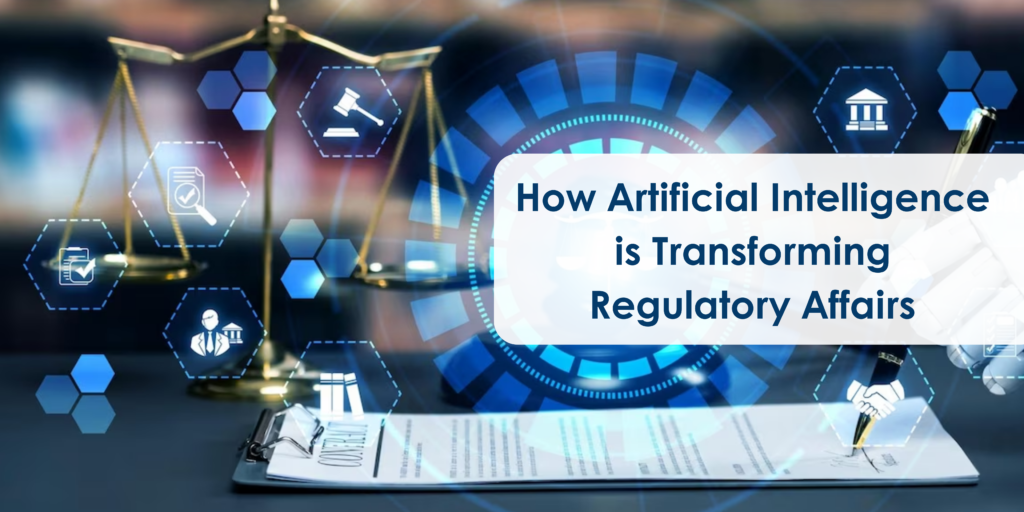The world of regulatory affairs, once a realm of meticulous document reviews and labyrinthine compliance procedures, is on the cusp of a revolution. Artificial intelligence (AI) is poised to become a game-changer, transforming how regulatory professionals navigate the complex and ever-evolving landscape. This blog delves into the exciting ways AI is taking flight in regulatory affairs, exploring its profound impact and the challenges and opportunities it presents.
Unveiling the Arsenal: AI’s Multifaceted Approach
The potential of AI in regulatory affairs is vast, encompassing a diverse range of applications:

- Automated Workhorses: Repetitive tasks that consume significant time and resources, like document classification, data extraction, and regulatory intelligence gathering, can be seamlessly handled by AI. Natural Language Processing (NLP) allows AI to sift through vast quantities of regulatory text, identifying key information and ensuring submissions adhere to specific formatting requirements. This frees up regulatory professionals to focus on strategic analysis and decision-making.
- Predictive Powerhouses: AI’s ability to analyze historical data and identify patterns can be harnessed to develop predictive models. These models can forecast potential regulatory hurdles during the development process, allowing companies to proactively address them and expedite approvals. For instance, AI can analyze safety data to predict potential adverse events, enabling companies to design more robust clinical trials.
- Risk Assessment Revolution: Regulatory compliance often involves navigating a complex web of risks. AI can leverage advanced algorithms to analyze regulatory requirements and historical data, pinpointing areas of potential non-compliance and suggesting mitigation strategies. This proactive approach minimizes the risk of regulatory delays and ensures products meet stringent safety standards.
- Global Reach, Streamlined Compliance: The life sciences industry operates in a globalized environment, with varying regulatory frameworks across borders. AI can be a powerful tool for navigating this complexity. Machine translation capabilities can translate regulatory documents into different languages, facilitating international submissions. Additionally, AI can analyze regulatory requirements from different regions and identify areas of convergence, allowing companies to develop products that comply with multiple jurisdictions.
The Tangible Benefits: A Boon for Regulatory Professionals
The integration of AI into regulatory affairs offers a multitude of benefits:
- Enhanced Efficiency: Automating tedious tasks frees up valuable time for human experts to focus on higher-level analysis and strategic decision-making. This leads to a more streamlined regulatory process and faster product approvals.
- Improved Accuracy: AI-powered tools can analyze vast amounts of data with meticulous precision, minimizing the risk of human error in document reviews and data entry. This ensures the accuracy and completeness of regulatory submissions.
- Cost Optimization: By automating tasks and reducing the need for manual data analysis, AI can lead to significant cost savings for companies. Additionally, faster regulatory approvals lead to quicker product launches and increased revenue potential.
- Data-Driven Decisions: AI provides access to deeper insights from regulatory data. This allows for more informed decision-making, enabling companies to tailor their regulatory strategies for optimal results.
Navigating the Hurdles: Challenges on the Rise
While AI offers a wealth of benefits, there are challenges to consider:
- Data Quality Imperative: AI algorithms are only as good as the data they are trained on. Ensuring the quality and consistency of regulatory data is crucial for effective AI implementation.
- Interpretability Issues: The “black box” nature of some AI algorithms can make it difficult to understand how they arrive at specific conclusions. This lack of transparency can be problematic for regulatory bodies and stakeholders who need clear justifications for AI-driven decisions.
- Ethical Considerations: Bias in training data can lead to biased AI algorithms. Addressing these biases and ensuring the ethical use of AI in regulatory processes is crucial.
- Regulatory Uncertainty: The regulatory landscape surrounding AI is still evolving. Regulatory bodies are still grappling with how to best oversee and integrate AI into the approval process.
The Future Beckons: Embracing the Transformative Power of AI
The rise of AI in regulatory affairs is not a matter of “if” but “when.” By embracing AI and its transformative potential, regulatory professionals can gain a significant competitive edge. Investing in AI-powered tools will be essential for navigating the increasingly complex regulatory landscape and ensuring the efficient and successful development and approval of life-saving therapies and technologies.
As AI continues to evolve, we can expect even more innovative applications to emerge. Collaboration between regulatory bodies, technology developers, and life sciences companies will be crucial to harnessing the full potential of AI and ensuring its responsible integration into the regulatory framework. The future of regulatory affairs is one where human expertise and AI-powered intelligence work in tandem, ushering in a new era of efficiency, accuracy, and innovation.

